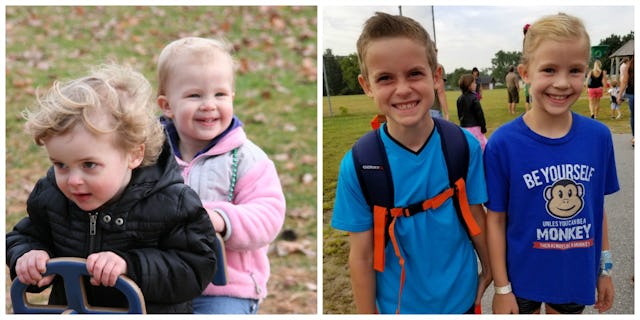The Beauty Of Girl-Boy Friendships

My daughter started daycare when she was six months old. She wasn’t crawling yet, but within a few days in her new space with babies her age, she met her best friend. He was a few months older, already on the move and would constantly crawl into her space. We would get pictures of my daughter and her bestie, a sweet and gentle brown-eyed boy who still looks at her with the same admiration, if not sibling-like annoyance, almost 8 years later.
Thankfully we, the parents, formed friendships too because there was no denying the special connection between our kids. Their spark ignited an unbreakable bond and our two families become close too. Their girl-boy friendship has allowed them to be who they are beyond the constraints society (and parents and peers) can place on gender. They challenge themselves and each other by challenging what it means to be a boy or girl just by being friends.
An article on A Mighty Girl, reminds us: “Kids are often encouraged — from direct verbal commands to more subtle suggestions such as through the types of toys they are given or the style of their clothing — to play in gender-specific ways. For example, if a girl loves both dolls and rough-and-tumble play, people around her — including her peers — will reward her for playing with the dolls and discourage her from roughhousing.”
It is too common and too easy to place kids into boxes based on the body parts they were born with. Babies are assigned gender labels based on sexual anatomy, even though gender and sex are not the same. But that assignment, that M or F on the birth certificate, creates a chain reaction of gender biases. Gender reveal parties, colors, clothing, toys, sports, activities are all slanted to be for boys or girls. And boys and girls are, even subconsciously at times, pushed toward those labels. This push is what makes boy-girl friendships extra special and valuable.
When different gender kids are friends, they are showing that they are more than what cartoons or books or other kids tell them they should be. They are humans lucky enough to find someone they feel comfortable and safe to explore common interests with. I have been fortunate to witness the benefits of this with my daughter and her best pal.
My daughter and her boy friend (not boyfriend because they are only 8 and who knows how their hearts will fall in love, so stop with the heteronormative romanticizing of boy-girl friendships) have inspired interests in each other too. You can’t really define that thing that leads to connection, but you can certainly see the compromise and exploration that can happen when the connection is strong.
My daughter has a big imagination. She likes theater, dancing, writing, and art. She also likes to burp. She farts A LOT (and very proudly), and eats like a full-grown athlete. Her buddy likes to build, play sports, and wrestle. He laughs at her noises and is disgusted at the same time. He eats like a bird and has better table manners than my daughter.
Their time together is spent creating worlds using Legos and magna-tiles full of characters that range from fairies to robots. They play dress up: he wears scarves and painted nails; she holds a clipboard and calls herself a ghost hunter. She is more outgoing and confident in new situations. He is more calm and a better problem solver. She gets irrational. So does he. He is more sensitive than she is. She is more competitive and is an awful loser. For everything someone says a girl should be, he is. And she embodies what it means to be a boy by many people’s judgments. When they are together all of it is blurred and they are showing us and each other that there is no one way to be a boy or a girl.
Even though my daughter and her buddy are raised in houses that encourage mixed-gender friendships, their bond has given them the confidence to carry this into other friendships. My daughter has several male friends and her buddy has other female friends. It just doesn’t occur to them that they shouldn’t be friends with someone who isn’t their gender. And because they are friends with different gender kids, by extension, they have access to their friend’s friends. The boy vs. girl notion lessens and the old playground rules of boys only play with boys fade away. Kids can see each other as equal. They can also begin to respect the fact that girls can be loud and boys can be sensitive.
A Mighty Girl also quotes Rachel Simmons, author of Enough As She Is, who explains that boys and girls tend to resolve conflict in different ways. “You want girls and boys to be exposed to different ways of conflict resolution, and to take them seriously from a young age. I want my daughter to be comfortable with both, and have the facility to move freely between the two. This will help her socially and professionally [in the future.]”
I want my daughter to have these conflict resolution skills too. I want her to have the confidence to stand up for herself while knowing there will be times when it’s appropriate to compromise. She is going to meet a lot of people in her life, and to better understand how they operate, it is important for my daughter to foster relationships with friends of all genders.
I am so glad my girl met her boy.
This article was originally published on